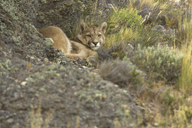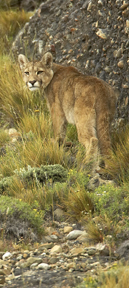



"We'll have them all day if we find
them. There will be plenty of time to come back for the gear then."
The advice of my guide sounded fine at the time, for I had walked
the undulating, and sometimes steep hillsides for several days
without luck, and the prospect of carrying a 600mm and camera
was not inviting. So Mary and I, and our guide, left our gear
in our vehicle and began hiking, searching for the third day in
a row for the elusive puma.
Mary had started out ahead while I checked another spot with the
vehicle and almost immediately she thought she had spotted a cat
lying beside a boulder several hundred yards away. She radioed
me to join her, where my 18X binoculars could confirm a sighting.
Nearly a half hour later I found her - amidst the canyons and
buttes of our South American location a lone figure is hard to
find! - but the cat proved to be a bush.
Our guide had stayed back at the car, ready to start transporting
gear if we had spotted the cat. Proving a false alarm, he headed
out for his own cross-country scouting, and Mary and I proceeded
in our separate directions. About a half hour later I rounded
a steep rise and decided to survey the surrounding cliffs and
hillsides - or rest, really. As I sat and eyeballed and glassed
the rocks I spotted, naked-eye, a pair of ears, big ears. From
my distance, nearly 200 yards away, I wasn't sure if I had ears
or not, if the shape was a head with ears or just my eyes playing
tricks on me. Binoculars confirmed it was a real head, and, to
my amazement, that it belonged to a puma!
 The cat moved up the rock and sat surveying the
countryside, and me, below it. I quickly radioed Mary, talking
her to a spot where she could see me, but nearly 300 yards further
away she couldn't make out the cat. Our plan had been that if
anyone had spotted a cat he, or she, were to stay with the cat
while the others went for the gear and returned. The lookout would
follow the cat if necessary, so I stayed, and Mary left, heading
downhill to the eventual rendezvous with our guide and tracker.
The cat moved up the rock and sat surveying the
countryside, and me, below it. I quickly radioed Mary, talking
her to a spot where she could see me, but nearly 300 yards further
away she couldn't make out the cat. Our plan had been that if
anyone had spotted a cat he, or she, were to stay with the cat
while the others went for the gear and returned. The lookout would
follow the cat if necessary, so I stayed, and Mary left, heading
downhill to the eventual rendezvous with our guide and tracker.
For an hour I sat watching the cat, 200 yards away, as it lay
on a rock just on the tip of the horizon. While I waited, with
a spectacular mountain background visible nearby, I wondered how
I could approach this very exposed cat and get a mountain background,
too, with the 600mm I would be using. While I watched, the cat
yawned, stretched, and got up, and walked slowly out of sight!
Mary, our guide, and our tracker - with all of our camera gear
- were no where in sight!
I ran up the hillside to attempt to find the cat, and as I neared
the top and rounded a slight rise, I was shocked to see the cat
just 60 yards away, stretched like a house cat on a window sill!
The puma hunkered down, flattening when it saw me, but I immediately
stopped and the cat relaxed. Over the next 30 minutes the cat
alternately slept, watched me, groomed, sat up and scratched,
slept, surveyed the surroundings, and slept - all within, at most,
80 yards of my position, and in full, direct sunlight!
Eventually my guide and tracker came back into radio contact and
I could direct them to my position, urging them to get here as
fast as they could. That was easier said than done, as my guide
was carrying a full pack with equipment, food, and a tripod, and
my poor tracker was carrying my awkward-to-carry 600 with a camera
attached. The tracker was in incredible shape but he twisted his
ankle and was slowed. I waited, watched, and writhed on the rock
in agony as I waited. Waiting can kill ya!
I was torn with the desire to run down the hill and relieve my
tracker of the pack, but I worried about getting my eyes off the
cat. So I stayed. As it were, when my guide appeared, I joined
him for a few minutes and, WITH MY EYES OFF THE CAT, it slipped
away. From a perfect position in clear view, within easy full-frame
range with my 600, in perfect light, for 30 minutes or more, the
cat had disappeared!
 I was practically screaming with frustration.
I couldn't believe the luck, and I mentally bashed myself for
taking my attention off the cat for even a minute. As soon as
my guide appeared I grabbed my gear, and the three of us spread
out, hoping to find the cat. As it was, I headed straight to where
the cat had been, and rounding the rock ledge she had been perched
on I spotted her, sitting in some vegetation just feet below where
she had been perched! Unfortunately, I was now only 60 feet from
the cat, and I worried that I was too close, too fast, for her
comfort.
I was practically screaming with frustration.
I couldn't believe the luck, and I mentally bashed myself for
taking my attention off the cat for even a minute. As soon as
my guide appeared I grabbed my gear, and the three of us spread
out, hoping to find the cat. As it was, I headed straight to where
the cat had been, and rounding the rock ledge she had been perched
on I spotted her, sitting in some vegetation just feet below where
she had been perched! Unfortunately, I was now only 60 feet from
the cat, and I worried that I was too close, too fast, for her
comfort.
I started shooting, she moved to another spot further uphill and
settled again. Mary, burdened with her gear and bad knees, was
still climbing, and as she got close the cat moved again, this
time going up and over the cliff. My tracker and I set off after
her to keep her in sight, but she disappeared. When Mary arrived,
fortunately, the cat reappeared for a brief 5 second glimpse as
it trotted to some trees far below our cliff. Our encounter was
over.
In all I watched the cat for nearly 2 hours. I was within 60-
yards, maybe even less, for almost a half hour, when the cat provided
poses that I'd die for. My shooting lasted ten minutes at best.
Afterwards I vowed to Mary, never again would I hike that country
without my gear. I certainly can't blame or fault my guide for
his advice - chances are, none of us were going to spot the cat
and if we had, past history said the cat would stay around. Carrying
a big lens over the rough country would certainly impact upon
my ability to move about, and upon my energy level, so it made
sense to travel light.
 I use a Kinesis long lens pack with an expandable
hood, so my 600mm with the hood mounted, my 1.4X, and a camera
can all be carried. Carrying the camera/lens/hood attached makes
for a 30 inch tall package which is very awkward to carry. To
date, the Kinesis system, and long lens bag, has proved the best
to use when carrying big lenses set up and ready to go, but when
covering ground, prospecting, having gear ready-to-go isn't a
vital requirement.
I use a Kinesis long lens pack with an expandable
hood, so my 600mm with the hood mounted, my 1.4X, and a camera
can all be carried. Carrying the camera/lens/hood attached makes
for a 30 inch tall package which is very awkward to carry. To
date, the Kinesis system, and long lens bag, has proved the best
to use when carrying big lenses set up and ready to go, but when
covering ground, prospecting, having gear ready-to-go isn't a
vital requirement.
After that experience, as I scouted for more puma, I broke my
equipment down, reversed my lens hood, and removed the camera,
which made carrying the equipment much, much easier. But I got
smart too late, we didn't spot another puma.
I got nice shots, but my elation was tempered by the fact that
I missed really outstanding images, fantasy-type shots, had I
had only 5 more minutes before the cat had moved from the rocky
ledge. Had I kept my eye on the cat when my guide appeared perhaps
it would not have moved - animals often slink to cover when they
know they are not being watched. And I was really disappointed
that Mary had only a fleeting glimpse, and after all that hard
work - hiking to the car, returning with her gear, she missed
getting shots by just a few minutes.
Oh well, that's the story and that's the Tip - Carry your gear!
Hopefully, next year I'll get another chance, but you can be sure
that, no matter what, I'll be carrying my equipment every time
I hike the backcountry looking for a South American puma!
PS One of the problems in carrying gear while scouting is the weight, which certainly tires one out over time. Another is the rather uncomfortable nature of carrying gear. I'll be addressing that issue in a later Tip of the Month.
| DIGITAL | EQUIPMENT | ADVICE | TRAVEL | WILDLIFE | FIELD TIPS |